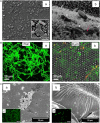Implication of Surface Properties, Bacterial Motility, and Hydrodynamic Conditions on Bacterial Surface Sensing and Their Initial Adhesion
- PMID: 33644027
- PMCID: PMC7907602
- DOI: 10.3389/fbioe.2021.643722
Implication of Surface Properties, Bacterial Motility, and Hydrodynamic Conditions on Bacterial Surface Sensing and Their Initial Adhesion
Abstract
Biofilms are structured microbial communities attached to surfaces, which play a significant role in the persistence of biofoulings in both medical and industrial settings. Bacteria in biofilms are mostly embedded in a complex matrix comprised of extracellular polymeric substances that provide mechanical stability and protection against environmental adversities. Once the biofilm is matured, it becomes extremely difficult to kill bacteria or mechanically remove biofilms from solid surfaces. Therefore, interrupting the bacterial surface sensing mechanism and subsequent initial binding process of bacteria to surfaces is essential to effectively prevent biofilm-associated problems. Noting that the process of bacterial adhesion is influenced by many factors, including material surface properties, this review summarizes recent works dedicated to understanding the influences of surface charge, surface wettability, roughness, topography, stiffness, and combination of properties on bacterial adhesion. This review also highlights other factors that are often neglected in bacterial adhesion studies such as bacterial motility and the effect of hydrodynamic flow. Lastly, the present review features recent innovations in nanotechnology-based antifouling systems to engineer new concepts of antibiofilm surfaces.
Keywords: antibiofilm surfaces; bacterial adhesion; bacterial motility; bacterial surface sensing; biofilm formation; hydrodynamics; material properties.
Copyright © 2021 Zheng, Bawazir, Dhall, Kim, He, Heo and Hwang.
Conflict of interest statement
The authors declare that the research was conducted in the absence of any commercial or financial relationships that could be construed as a potential conflict of interest.
Figures





References
-
- Abdalla M. M., Ali I. A. A., Khan K., Mattheos N., Murbay S., Matinlinna J. P., et al. (2020). The influence of surface roughening and polishing on microbial biofilm development on different ceramic materials. J. Prosthodont. (in press). - PubMed
Publication types
Grants and funding
LinkOut - more resources
Full Text Sources
Other Literature Sources

